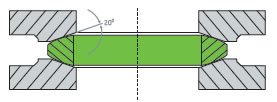Lens ring flange joints and how they are machined
The lens ring type of flange joint is used to create a seal in high temperature and high pressure piping systems. This joint differs from the standard raised face flange joint (which has a ‘flat’ sealing face), by having a sealing face angled at 20° down towards the center of the bore. This type of joint is not used on very large flanges, with typical outside diameters of the lens ring gaskets ranging from 20mm up to 385mm.
How does a lens ring joint create a seal?
The lens ring gasket is a made using a metal softer than the flange so that the gasket plastically deforms on compressive load, rather than the flange. The lens cross section includes a spherical sealing surface and requires special angles machined on the 2 connecting flange surfaces. In accordance with DIN 2696 and to meet ASME B16.5 standards, only certain specified grades of Carbon Steel, Stainless Steel can be used for lens ring gaskets.
Applications of lens ring flange joints
Lens ring gaskets can withstand high temperatures and high pressures at the same time. This makes them suitable for the oil, gas, petrochemical and offshore industries. Typical installations include flanged joint connections on valves, pipe-work assemblies and vessel joints.
Advantages of lens ring gasket:
Compared with other types, lens ring gaskets will seal with a smaller bolt load, because the contact area is very small).
The contact surface between the spherical flange and the spherical lens ring gasket increases when strong pressure is applied.
The gasket’s design and elastic deformation properties provide an additional advantage of being able to reuse it several times.
Lens ring gaskets are less sensitive to over-stressing, due to distribution of compressible loads spreading over the gasket facings.


